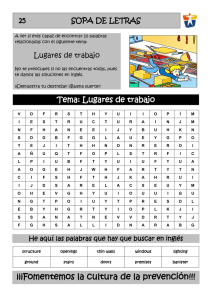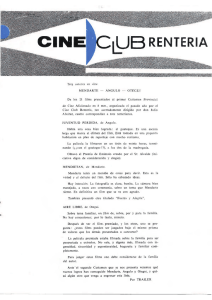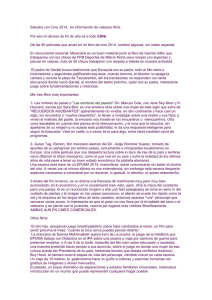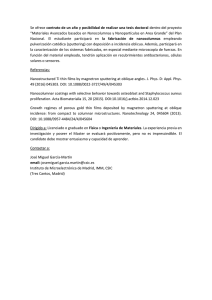Explorando materiales: películas delgadas
Anuncio
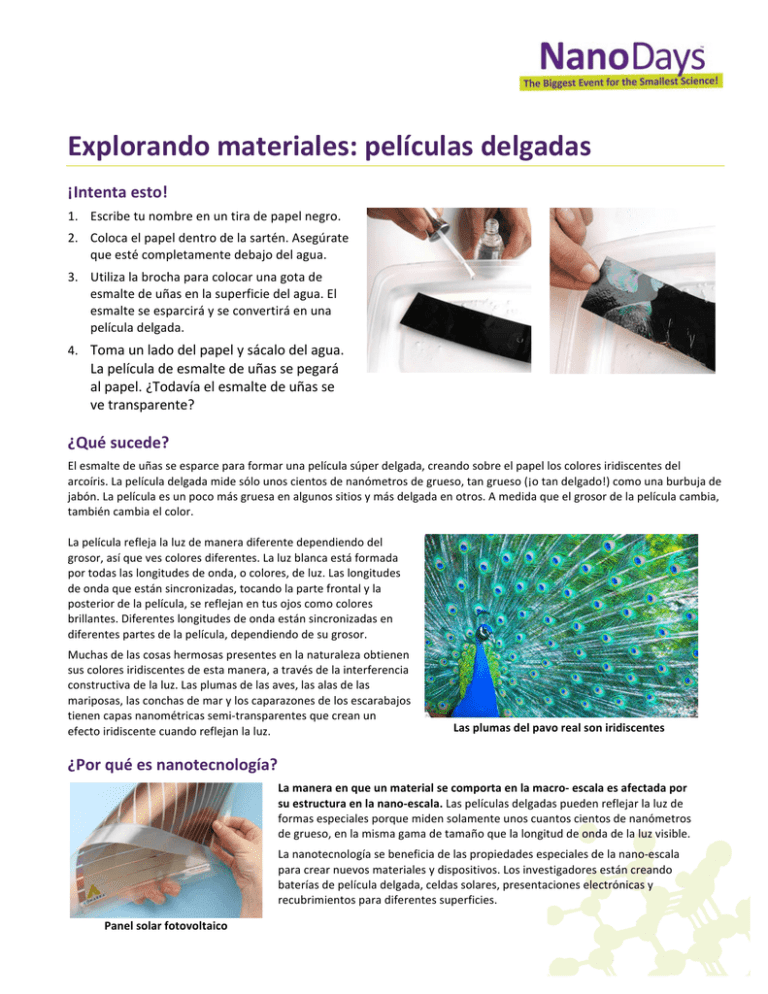
Explorando materiales: películas delgadas ¡Intenta esto! 1. Escribe tu nombre en un tira de papel negro. 2. Coloca el papel dentro de la sartén. Asegúrate que esté completamente debajo del agua. 3. Utiliza la brocha para colocar una gota de esmalte de uñas en la superficie del agua. El esmalte se esparcirá y se convertirá en una película delgada. 4. Toma un lado del papel y sácalo del agua. La película de esmalte de uñas se pegará al papel. ¿Todavía el esmalte de uñas se ve transparente? ¿Qué sucede? El esmalte de uñas se esparce para formar una película súper delgada, creando sobre el papel los colores iridiscentes del arcoíris. La película delgada mide sólo unos cientos de nanómetros de grueso, tan grueso (¡o tan delgado!) como una burbuja de jabón. La película es un poco más gruesa en algunos sitios y más delgada en otros. A medida que el grosor de la película cambia, también cambia el color. La película refleja la luz de manera diferente dependiendo del grosor, así que ves colores diferentes. La luz blanca está formada por todas las longitudes de onda, o colores, de luz. Las longitudes de onda que están sincronizadas, tocando la parte frontal y la posterior de la película, se reflejan en tus ojos como colores brillantes. Diferentes longitudes de onda están sincronizadas en diferentes partes de la película, dependiendo de su grosor. Muchas de las cosas hermosas presentes en la naturaleza obtienen sus colores iridiscentes de esta manera, a través de la interferencia constructiva de la luz. Las plumas de las aves, las alas de las mariposas, las conchas de mar y los caparazones de los escarabajos tienen capas nanométricas semi-­‐transparentes que crean un efecto iridiscente cuando reflejan la luz. Las plumas del pavo real son iridiscentes ¿Por qué es nanotecnología? La manera en que un material se comporta en la macro-­‐ escala es afectada por su estructura en la nano-­‐escala. Las películas delgadas pueden reflejar la luz de formas especiales porque miden solamente unos cuantos cientos de nanómetros de grueso, en la misma gama de tamaño que la longitud de onda de la luz visible. La nanotecnología se beneficia de las propiedades especiales de la nano-­‐escala para crear nuevos materiales y dispositivos. Los investigadores están creando baterías de película delgada, celdas solares, presentaciones electrónicas y recubrimientos para diferentes superficies. Panel solar fotovoltaico Learning objectives 1. The way a material behaves on the macroscale is affected by its structure on the nanoscale. 2. The thin film reflects light differently depending on how thick it is, so you see different colors. Materials • • • • • • Shallow pan Strips of black paper Clear nail polish Permanent markers in metallic color Peacock feather (optional) Thin film solar cell sample (optional) Bristol paper works best for this activity. You can use regular construction paper, but a lot of color will bleed from the paper into the water. The nail polish should be completely clear (no shimmer or glitter), and regular formula (not fast-­‐drying). Notes to the presenter SAFETY: Do this activity in a well-­‐ventilated area. Before you begin: • Fill the pans halfway with water. • Set up an area to let the strips of paper dry. Black paper is used for this activity because it absorbs all visible light. The colors that appear are created by the interaction of light with the thin film. Writing their name with the permanent marker helps visitors find their thin film later. The marker doesn’t make the colors appear on the black paper—that’s the thin film created by the nail polish. Related educational resources The NISE Network online catalog (www.nisenet.org/catalog) contains additional resources to introduce visitors to nanomaterials: • Public programs include Aerogel, Biomimicry: Synthetic Gecko Tape Through Nanomolding, Nanoparticle Stained Glass, Nanosilver: Breakthrough or Biohazard? and World of Carbon Nanotubes. • NanoDays activities include Exploring Materials—Ferrofluid, Exploring Materials—Liquid Crystals, and Exploring Structures—Buckyballs. • Exhibits include Bump and Roll, Changing Colors, and Unexpected Properties. Thin Film Background Information What are thin films? A thin film is a layer of material ranging from less than a nanometer (one billionth of a meter) to several micrometers thick. Everyday examples of thin films include soap bubbles, oil slicks on water, and anti-­‐reflection coating on eyeglasses. Why do some thin films have beautiful colors? Light travels in waves. Just like water waves, light waves have crests (high points) and troughs (low points). The distance between crests is a wavelength. Different colors of light have different wavelengths. The wavelength of visible light ranges from about 400-­‐700 nanometers. The nanostructures of iridescent feathers, shells, and wings are in this same size range. So are thin films. Light can interact in special ways with very tiny structures, like those found in nature and in nanotechnology. White light is made up of all wavelengths, or colors, of light. When white light hits a thin film, some of the light is reflected from the front surface of the film, and some travels through it and is reflected from the back surface. If the waves reflected from the front and back have crests that overlap, they reinforce each other and the reflected color is bright. This is called constructive interference. If the waves reflected from the front and back have crests that overlap with troughs, the waves cancel each other out and the reflected color is dim. This is called destructive interference. The thickness of the film determines which colors will be bright and which will be cancelled out. In a very thin film (less than 400 nanometers thick) all the colors cancel out, and the film appears black. How are thin films used? Scientists are developing thin films to use as computer memory and in solar cells. Flexible thin film batteries can be made by printing onto plastic, thin metal foil or paper. Thin films are expected to have cheaper manufacturing and materials costs than conventional materials. Thin film solar panels Credits and rights This activity was adapted from “Create Some Iridescent Art,” in the DragonflyTV Nano Educator’s Guide, published by Twin Cities Public Television, 2009. The original activity is available at: www-­‐tc.pbskids.org/dragonflytv//web_assets/pdf/dftv_nanoedguide_butterflywings.pdf Thin film solar panels included in the NanoDays kits courtesy of Konarka Technologies. Photo of solar panel array in the public domain, from Wikimedia. This project was supported by the National Science Foundation under Award No. 0940143. Any opinions, findings, and conclusions or recommendations expressed in this program are those of the author and do not necessarily reflect the views of the Foundation. Copyright 2010, Sciencenter, Ithaca, NY. Published under a Creative Commons Attribution-­‐Noncommercial-­‐ ShareAlike license: http://creativecommons.org/licenses/by-­‐nc-­‐sa/3.0/us/
